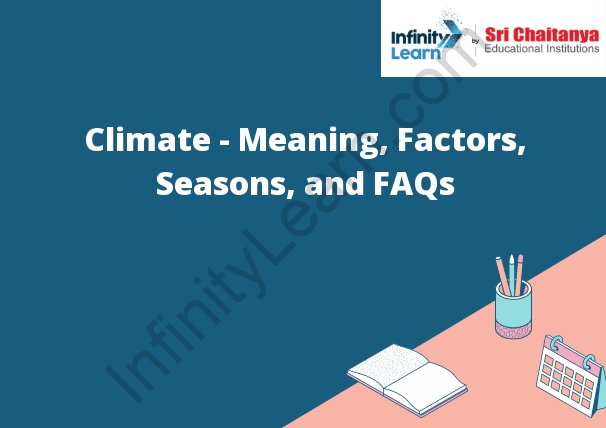Table of Contents
Meaning of Climate
Climate is the average weather conditions in a particular area over a long period of time. It is determined by the region’s latitude, elevation, and proximity to water. Climate is important because it affects the way people live and the type of plants and animals that can survive in an area.

Weather Definition
Weather is the state of the atmosphere at a given time and place, with respect to temperature, humidity, wind, and other meteorological conditions.
Climatic Controls
Climate controls are the environmental factors that influence climate. The most important climate controls are the Earth’s orbit around the sun, the Earth’s tilt on its axis, and the ocean currents.
Factors Affecting India’s Climate
The climate of India varies considerably from region to region, because of the country’s vast size and its location in different climatic zones.
The northernmost part of India is in the Himalayan mountain range, which has a cold climate. The central part of the country has a hot, dry climate, while the southern part of India has a hot, humid climate.
Several factors affect India’s climate, including its location on the Earth, its altitude, and the weather patterns of the Indian Ocean and the Atlantic Ocean.
The Indian Monsoon
is a seasonal reversing wind that blows over the subcontinent of India. The monsoon occurs every year between June and September. The southwest monsoon winds blow from the Indian Ocean over the Arabian Sea and the Bay of Bengal, bringing moisture-laden air to the subcontinent. The monsoon rains fall over most of India, with the exception of the northeastern part of the country.
The monsoon is a result of the differential heating of the Earth’s surface. The sun’s radiation is most intense near the equator, and the Earth’s surface there is heated more than the surface at the poles. This causes the air near the equator to rise, and the air at the poles to sink.
The Earth’s rotation also contributes to the movement of air. The rotating Earth causes the air at the equator to move faster than the air at the poles. This causes the air to move from the equator to the poles, and the air at the poles to move to the equator. The monsoon is the result of this global air movement.
The Onset of the Monsoon and Withdrawal of the Monsoon
The onset of the monsoon is the start of the rainy season in India. The monsoon arrives in the Bay of Bengal in early June and moves inland, reaching Delhi by the end of the month. The monsoon reaches Rajasthan and Gujarat by the end of July. The withdrawal of the monsoon is the end of the rainy season in India. The monsoon begins to retreat from the Indian coast in early September and is completely gone by the end of the month.
How Different Parts of India Experiences the Arrival of Monsoon?
The arrival of monsoon in India is experienced differently in different parts of the country.
In the North, the monsoon arrives in the last week of June. The rains are heavy and the weather is hot and humid. The North experiences the monsoon till the end of September.
In the East, the monsoon arrives in the first week of June. The rains are moderate and the weather is hot and humid. The East experiences the monsoon till the end of September.
In the West, the monsoon arrives in the first week of June. The rains are moderate and the weather is hot and humid. The West experiences the monsoon till the end of September.
In the South, the monsoon arrives in the first week of June. The rains are light and the weather is hot and humid. The South experiences the monsoon till the end of September.
Withdrawal of the Monsoon
The withdrawal of the monsoon is the shift in the direction of the monsoon winds from their summer location to their winter location. This event typically occurs in October or November.
The Seasons
The four seasons in the United States are winter, spring, summer, and fall.
The Hot Weather Season (Summer)
Summer is the time of year when the weather is hottest. In the summer, the sun shines the longest and the days are the longest.
Advancing Monsoon (The Rainy Season) in India
The monsoon season in India usually begins in late May or early June and continues through September. The southwest monsoon winds bring moisture from the Indian Ocean to the subcontinent, resulting in heavy rains and thunderstorms.
The monsoon season is an important time of year for the people of India. The rains help to irrigate the crops and provide water for the people and animals. The storms can also be dangerous, however, causing flooding and destruction.
Retreating/Post Monsoons (The Transition Season)
The retreating monsoon is the transitional season between the monsoon and the dry season. It generally lasts from October to November in India.
The retreating monsoon is a time when the weather is quite changeable. There can be spells of warm weather, but also of cooler weather with rain or even thunderstorms. This is the time of year when the weather is most difficult to predict.
Distribution of Rainfall in India
The rainfall in India is not uniformly distributed throughout the country. It is highest in the Himalayas and the north-eastern region and decreases towards the south and the west. The average annual rainfall in India is about 1,100 mm.
Monsoon as a Unifying Bond
The monsoon is an important unifying force in India. It is the reason why there is such a strong cultural affinity among the people of India, even though they come from diverse linguistic and ethnic backgrounds. The monsoon also plays a significant role in the country’s economy, as it is responsible for the majority of the rainfall that India receives.







